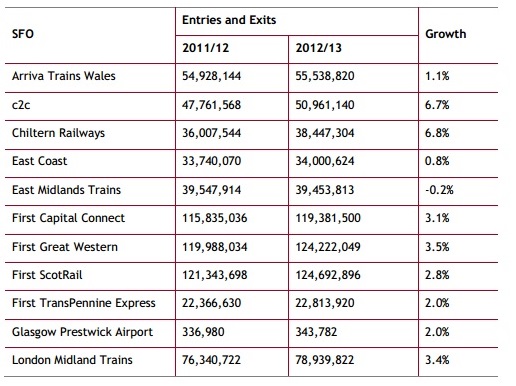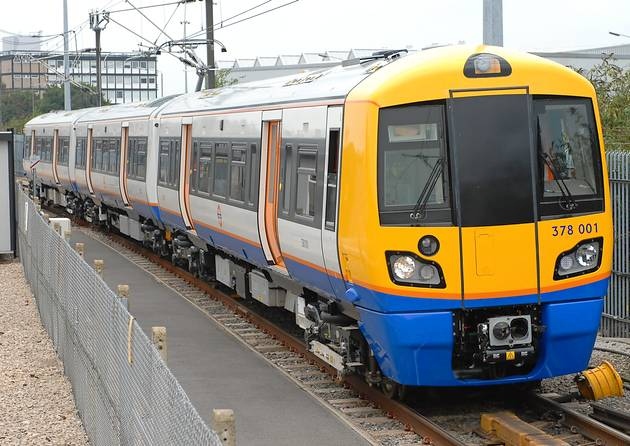Railway Station Usage Figures Released
Figures have been released showing passenger numbers across the country in the year 2012/13. Here are the figures for the North Kent line from Slade Green to Deptford via Greenwich.
Overall Southeastern have the seventh lowest increase in passengers across the UK.
Southeastern also have the smallest increase of any commuter franchise serving suburban London. It lags behind all others at 1.7% growth. London Overground, prevented from taking over Southeastern’s London metro routes at the end of 2013, shows rapid growth of 18.3%.
So what’s the reason for this? Population growth is high amongst area served by southeastern in London. In addition this covers the year of the olympics which should have boosted figures. Charlton saw a decline despite being a designated station for olympic visitors. One affect skewing the overall figures may be that many Kent stations show declines. This is evident in the Medway towns with declines at Gravesend, Greenhithe (Bluewater) and Gillingham. Dartford also shows a decrease. This could be skewing overall figures but a few London stations still show declines and those with increases are often below the national average, let alone London.
I think it’s a number of issues. Many southeastern stations in London are un-staffed all day. In addition there are no guards at all checking tickets on metro trains. Ticketless travel is far easier than other networks. Even if there are barriers they are left open most of the day. They are sometimes in use for a couple of hours at peak times, though there is almost always an alternative entrance without barriers. Are any stations staffed from opening all the way to closure? Even major stations such as Woolwich Arsenal close the ticket offices and open barriers in the early evening.
Many other networks across London have barriers in operation all day until past midnight. London Overground does on the majority of its services, as does the Underground. This not only increases safety but prevents ticketless travel. Some of Southern’s major routes in south London run on London Overground routes and so have barriers from the first service to the last. This is funded by London Overground. Of course, other franchises and routes do have unstaffed stations and a lack of barriers, but will often have guards on board every service checking tickets along the train. Across southeastern’s London network no barriers is the norm at the vast majority of stations along with no guards. The result is that unless travelling to a central London station, travelling without a ticket is very easy.
Fares
In addition southeastern could be suffering the cumulative effects of years of greater increases in fares compared to other franchises. The southeastern franchise had the highest fare increases of any UK franchise from 2006 to 2011, of inflation plus 3% each year. Other franchises had inflation + 1%.
Southeastern was nationalised in late 2003 after the failure of the Connex south eastern franchise. After 2 1/2 very successful years, with increasing reliability and vastly improved passenger communications, the company was re-privatised. That was in 2006, under Tony Blair’s Labour government with Brown in the treasury and Alistair Darling as Transport minister. The new franchise agreement stipulated the UK’s highest fare increases, plus slowed down many routes from Kent into London to ‘encourage’ people onto the new High Speed 1 services to St Pancras. Those new services were priced at a very high level and are only of benefit to select Kent commuters, yet all southeastern users were penalised, including London commuters.
That legacy of continual increases since 2006, above other franchises, could well have priced many off. Since the coalition came to power they have maintained a policy of high fare increases, though have abolished the additional increase southeastern had above other franchises.
Infrequent service levels could be another reason for poor growth. Once frequencies reach a level of (at least) one train every 15 minutes the service becomes a ‘turn up and go’ service. People know that they won’t have to wait too long at the platform. Advanced planning isn’t necessary before setting off. One of London Overground’s core strengths has been to increase as many services as possible to 4 trains an hour, at least, and late into the evening. This is what they were proposing for southeastern metro routes until blocked from taking over. Many southeastern routes currently drop to 2 trains an hour after 8 or 9pm and on Sundays. Thus you could be in line for a long wait. A cancellation then leaves a possible hour long wait. Compared to almost every other London rail route, and of course the underground, this is a terrible level of service which is holding back growth. Where services have been improved above 2 trains an hour across London and the UK, passenger numbers have responded with large growth.
Reliability & Train Length
Then there is the question of reliability. Southeastern have had periods of terrible punctuality. Much is beyond their control and is due to Network Rail. With that in mind it is still the case that too much has been a result of trains with maintenance faults. Given this, where people can use alternatives such as North Greenwich tube station, they will. This could factor in to Charlton’s figures.
Given the ease in avoiding paying for travel, I think these figures could well under-represent true passenger numbers. In addition there is huge latent demand if services improve to the standards elsewhere in London. It is worrying if figures are not showing true passenger numbers and untapped potential is not being realised, as this could affect future investment levels. The cycle then becomes embedded; investment is lower and passenger numbers stagnate.
Southeastern are one of the few franchises that have no plans for any new London commuter rolling stock in the coming years. Southern have large orders for 170 new carriages, with new trains arriving weekly. Thameslink have an order for 1200 new carriages. TfL will take over some Greater Anglia lines in 2015 and are in the process of ordering new trains both for their current services and the Anglia lines. The trains freed up by that could be used to lengthen trains elsewhere for Greater Anglia passengers. First Great Western commuter lines are being electrified. They will receive more trains – either from Thameslink or a new order. South West trains are also being lengthened right now with 60 additional carriages.
Southeastern is enjoying no such luck. Packed out 4 carriage trains at rush hour look set to continue on some routes. The London Bridge rebuild makes things difficult in the immediate future but new stock will be needed by 2018. Perhaps sooner if not enough trains can be strengthened to 12 carriages from 2015. The Department for Transport may also hope that Crossrail will reduce the need for new trains come 2018, but it is looking like it could be full on day one.
Running a site alone takes time and a fair bit of money. Adverts are far from enough to cover it and my living costs as a private renter.
You can support me including via Paypal here Another option is via Patreon by clicking here You can also buy me a beer/coffee at Ko-fi here There's also a Facebook page for the site here Many thanks



Pingback: Southeastern Train Cuts & London Bridge Rebuilding: The Options | fromthemurkydepths